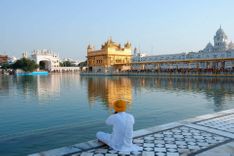Mohammad Thasin, calligrapher
The setting cinnamon sun reddens the great marble domes of the Jama Masjid, Delhi’s largest mosque, as white-capped crowds gather for evening prayers.
Across the road, in a forgotten alleyway, Mohammad Thasin sits at his usual bench – the same bench he has sat at every day for the last 32 years – sketching silently; intricate ink strokes scratched onto crisp card.
“Ten years ago I wouldn’t have been able to talk to you,” he says, laying his wooden utensil down. “I was so busy working I didn’t even have time to eat.”
Nothing can match the hand's work. You can see the love that has gone into it
Mohammad started drawing as a hobby, sneaking into movie theatres after school and sketching the characters he saw on screen. He began selling his work, and due to his ability to write in English, Hindi and Urdu, made a good living as a professional scribe, regularly producing posters, signs and pamphlets.
But that all changed with the introduction of computers, allowing text and images to be produced and printed cheaply.
“Now sometimes I have one customer a day,” he says, “sometimes I have no customers for two or three days.”
Mohammad survives on a handful of regular clients who are happy to pay a little extra for hand-drawn work, which, in his opinion, is vastly superior to the digital offering.
“There is no texture [in digital work],” Mohammad says dismissively, “Nothing can match [the] hand's work. You can see the love that has gone into it.”












